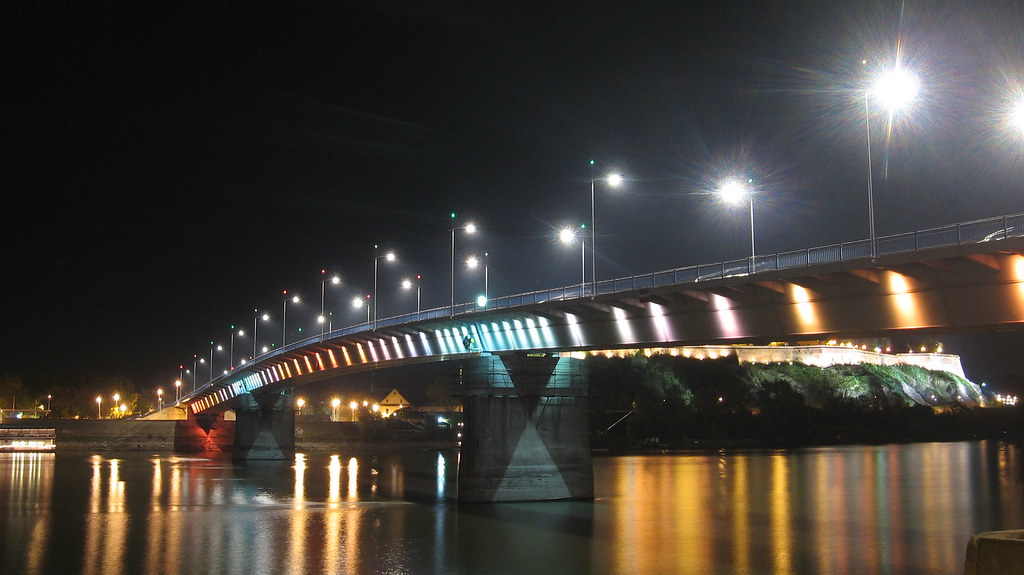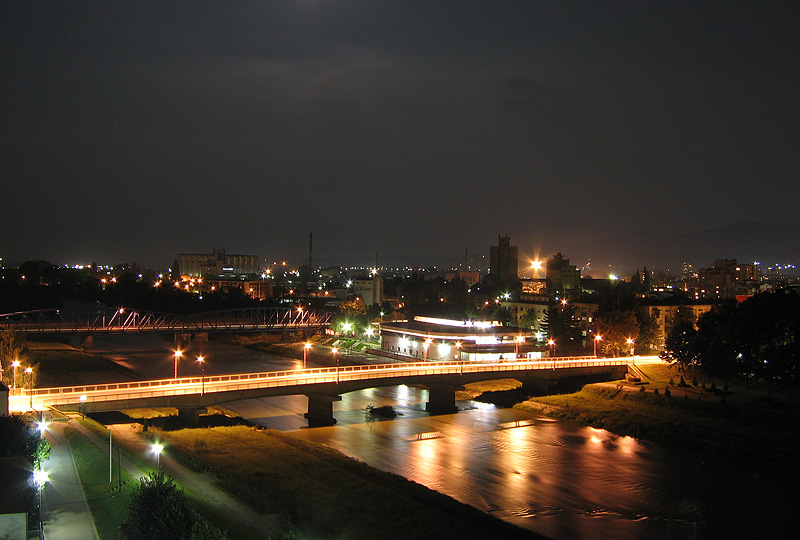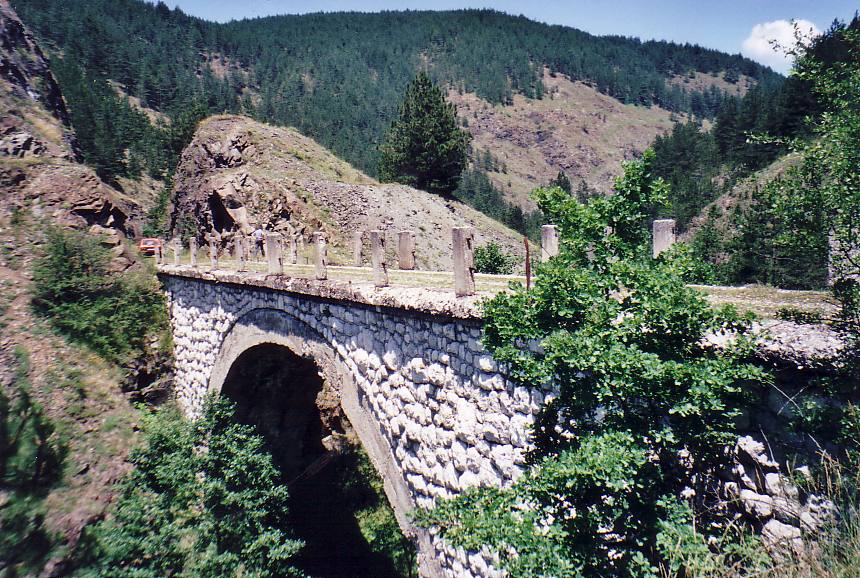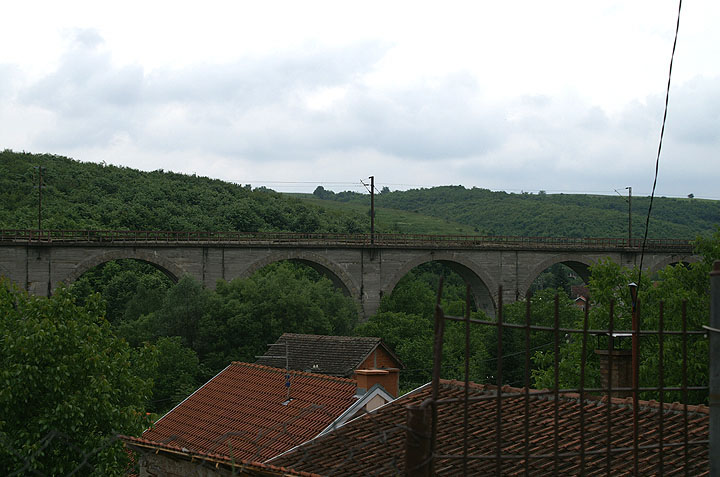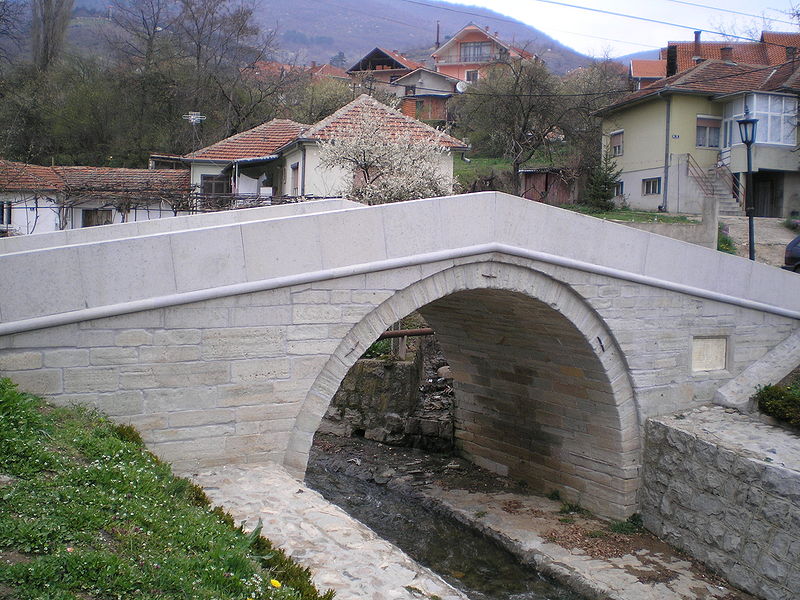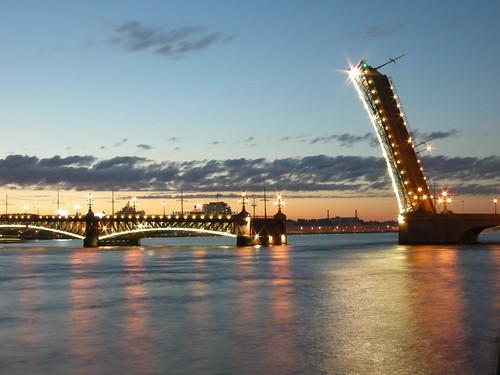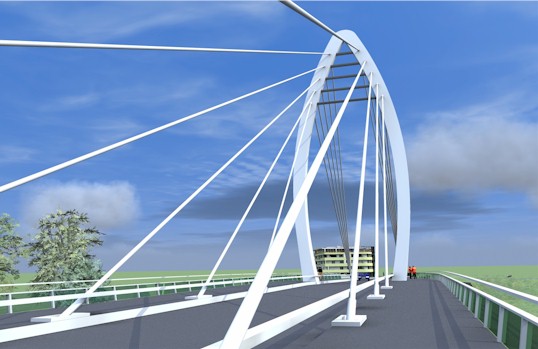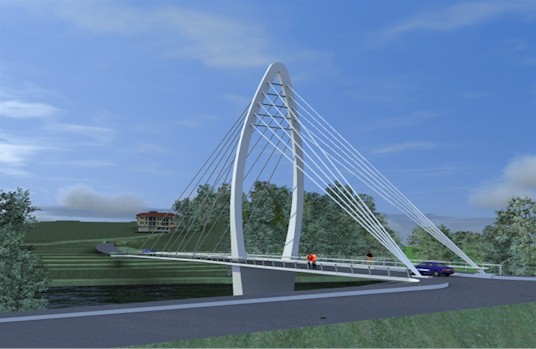Install the app
How to install the app on iOS
Follow along with the video below to see how to install our site as a web app on your home screen.

Beleška: this_feature_currently_requires_accessing_site_using_safari
Koristite zastareli pregledač. Možda neće pravilno prikazivati ove ili druge veb stranice.
Trebali biste nadograditi ili koristiti alternativni pregledač.
Trebali biste nadograditi ili koristiti alternativni pregledač.
Mostovi
- Začetnik teme death row
- Datum pokretanja
Član
- Učlanjen(a)
- 05.09.2009
- Poruka
- 7.315
10 Most Beautiful Bridges in the World
10. Khaju Bridge
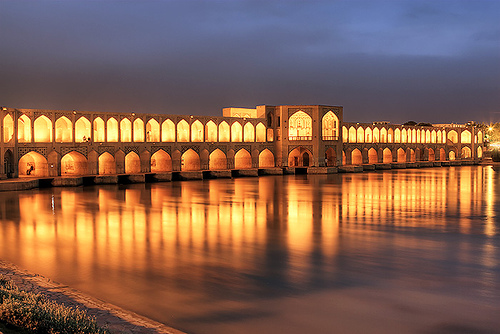
Photo: twocentsworth
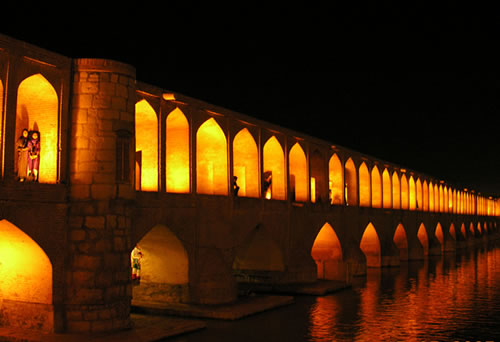
Khaju Bridge at night. Photo: Jovika
The Khaju Bridge (Pol-e-Khajoo) in Isfahan, Iran, was built in the 17th century by Shah Abbas II. The bridge also serves as a dam, with sluice gates under the archways. When the gates are closed, the water level behind the bridge is raised to irrigate gardens alongside the Zayandeh River.
The Khoju Bridge has two stories of arcades, marked by the distinctive intersecting arches decorated with richly colored tiles. At the center of the bridge, there are two large pavilions, called the Prince Parlors, that were originally reserved for the Shah.
9. Pont du Gard
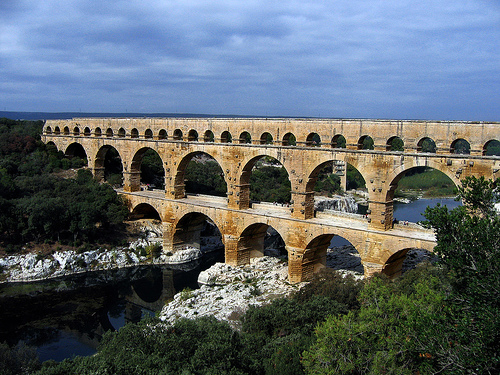
Pont du Gard. Photo: zak mc
Pont du Gard, an aqueduct spanning the Gard River in southern France, is a masterpiece of Roman engineering. It wasn’t built to transport people (though there is a pedestrian footbridge on it) – instead, it was part of a complex aqueduct system that carried water over 30 miles (about 50 km) to the ancient Roman city of Nemausus (now Nîmes).
The Pont du Gard was built by Marcus Vipsanius Agrippa (63 – 12 BC), the son-in-law of Caesar Augustus. The bridge’s stones, some of which weigh up to 6 tons, were cut perfectly to fit together without any mortar.
The wedge-shaped stones, known as voussoirs, were arranged in three levels, the top-most being the water conduit. So precise was the engineering that the entire system descends only 56 ft. (17 m) vertically – over 30 miles! – to deliver 5 million gallons (20,00 m3) of water to the city.
8. Bridge of Sighs

In the 19th century, Lord Byron named a Venetian limestone bridge across the Rio di Palazzo connecting the Doge’s prison to the interrogation room in the main palace, the Bridge of Sighs (Ponte dei Sospiri). Supposedly, the prisoners would sigh when they look out the window – with stone bars no less – to see their last view of beautiful Venice before their imprisonment, torture or execution.
In reality, Doge’s prison held mostly small-time criminals. Also, the bridge was built in 1600 by Antonio Contino, after the days of the inquisitions and summary executions. Legend has it that if lovers kissed on a gondola underneath the Bridge of Sighs at sunset, their love would last for eternity.
7. Iron Bridge
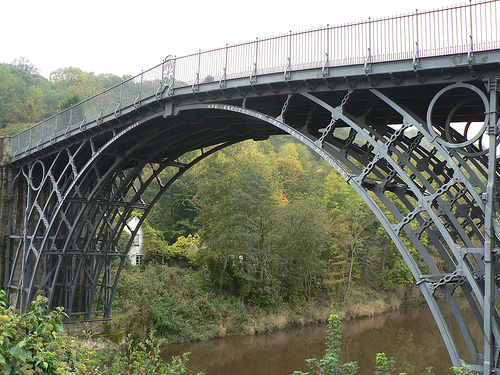
Iron Bridge. Photo: johnmuk
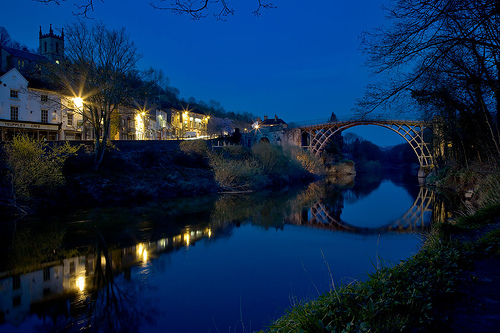
Iron bridge at night. Notice how the bridge and its reflection make a perfect circle.
Photo: Mark Haythorne
The Iron Bridge, spanning the Severn river in Shropshire, England, isn’t a particularly large or ornate bridge, but it does have something that made it unique: it’s the first bridge made completely out of cast iron. In the 18th century, Shropshire was rich in iron and coal – indeed, there were more iron factories within two-mile radius of the town than any other city in the world. It was also there that iron was first smelt with coke. So it was only natural that the bridge would be made out of iron, a stronger alternative to wood. (Photo of the railing: [ame="http://www.flickr.com/photos/cactus23/2252863037/"]ironbridge_03a on Flickr - Photo Sharing!@@AMEPARAM@@http://farm3.static.flickr.com/2018/2252863037_7a85d9e9a1_m.jpg@@AMEPARAM@@2252863037@@AMEPARAM@@7a85d9e9a1[/ame] [Flickr])
Architect Thomas Farnolls Pritchard proposed a single arch bridge that would let boats pass underneath, but he died before the bridge was built. The construction of the Iron Bridge was carried out by a local master ironworker named Abraham Darby III. About 400 tons (363 tonnes) of cast iron was used, with about 800 separate castings. The Iron Bridge has 5 arch ribs, each cast in two halves. It only took three months to put the parts together (which they did using screws instead of bolts!).
The ease and speed of the Iron Bridge’s construction helped convince engineers of the versatility and strength of iron, and helped usher in the Industrial Revolution era. Darby, however, didn’t fare so well: he severely underestimated the cost to build the bridge, and remained in debt for the rest of his life.
6. Covered Bridges
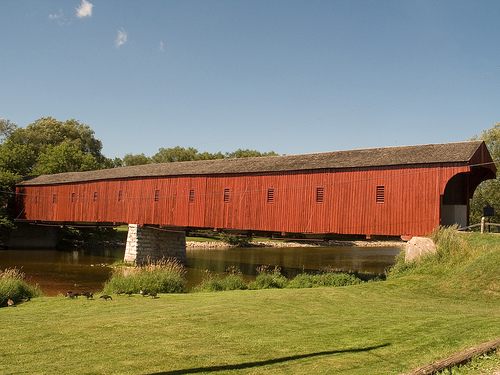
The West Montrose Covered Bridge on the Grand River, Ontario, Canada. It’s known locally as the Kissing Bridge. Photo: gojumeister
Covered bridges are simply that: bridges that have enclosed sides and roof. Though technically the Bridge of Sigh, Ponte Vecchio, and the Wind and Rain Bridges in this list are covered bridges, this term usually means simple, single-lane bridges in rural settings.
Before they are made famous by the 1995 Clint Eastwood film The Bridges of Madison County, "kissing bridges" or "tunnels of love" have been the pride and joy of many small towns across Europe and especially Northern America where more than ten thousands of such bridges were built.
In the 19th century, timber was plentiful and cheap (or, in many cases, free). So it’s natural that these bridges were made of wood. But why were they covered? Well, lovers aside, the real reason was much more practical: the wooden beams of the bridge lasted longer when protected from the elements.
Unfortunately, due to neglect, theft of lumber, vandalism, and fire, most covered bridges in the United States and Canada have disappeared.
5. Ponte Vecchio
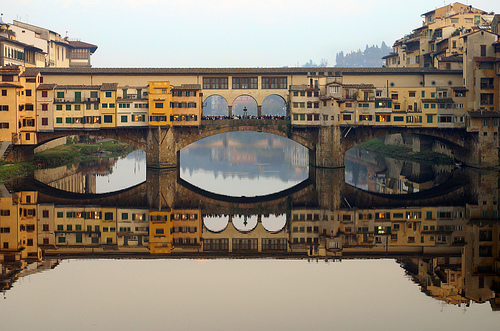
Ponte Vecchio. Photo: G|o®g|O
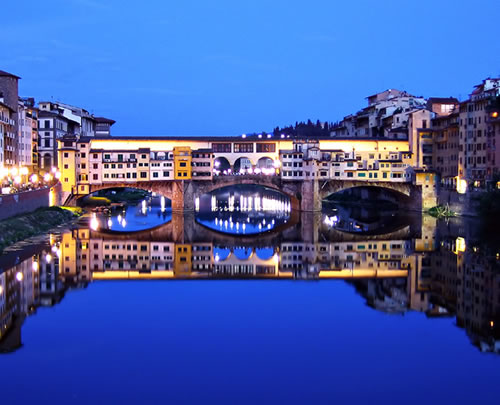
Ponte Vecchio at night. Photo: MrUllmi
The Ponte Vecchio is a medieval bridge over the Arno River. Actually, it’s much more than a bridge – it’s a street, a marketplace, and a landmark of Florence, Italy.
The Ponte Vecchio that we know today was built in 1345 by Taddeo Gaddi after an older span was destroyed in a flood. To finance the bridge, lots along the roadway were rented out to merchants, especially butchers and tanners, to hawk their wares.
In 1565, Duke Cosimo I de Medici ordered an architect named Giorgio Vasari to construct a roofed passageway. Soon after, jewelers, goldsmiths, and merchants of luxury goods pushed out the butchers out of Ponte Vecchio. Centuries of haphazard additions gave the bridge’s distinctive, irregular appearance today.
During World War II, after having survived many floods, the bridge faced its gravest threat: German bombers were blowing up bridges in Florence. It was a direct order from Hitler that spared Ponte Vecchio from certain destruction.
It is said that the word "bankruptcy" came from Ponte Vecchio. When a merchant failed to pay his debt, the table ("banco") he used to sell his wares was broken ("rotto") by soldiers. Not having a table anymore ("bancorotto"), meant the seller was bankrupt.
4. The Wind and Rain Bridge
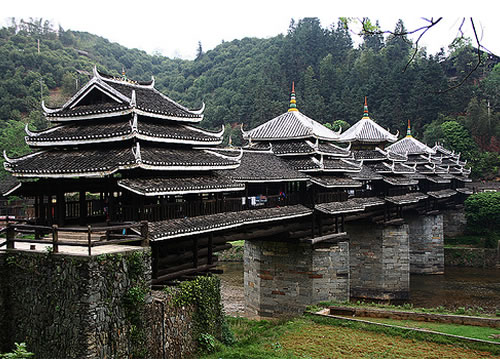
Chengyang Bridge. Photo: mazakii that genius
The wind and rain bridges were a type of bridge built by the Dong people (a minority ethnic group) in China. Because they live in the lowlands and the valleys with many rivers, the Dong people are excellent bridge builders. They are called "wind and rain" bridges because the covered bridges not only let people cross the river, but also protect them from the elements.
The Dong people don’t use nails or rivets to build these bridges – instead, they dovetail all of the wood. The largest and most magnificent is the Chenyang Bridge, spanning the Linxi River near the Dong village of Maan. The bridge is about 100 years old, and like all wind and rain bridges, it was built without a single nail.
3. Brooklyn Bridge

Brooklyn Bridge. Photo: Dennis Gerbeckx
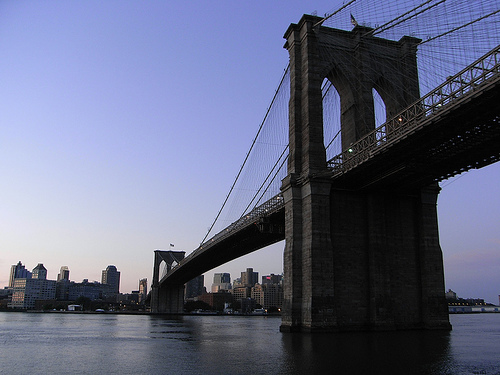
Brooklyn Bridge at sunrise. Photo: LemonSunrise
In 1855, engineer John Roebling started to design a bridge that at the time would be the longest suspension bridge in the world, with towers being the tallest structures in the Western Hemisphere: the Brooklyn Bridge in New York.
Today, the Brooklyn Bridge is one of the main crossings of the East River and one of the most heavily trafficked bridges in the world. But in the late 19th century, it took Roebling more than 14 years to convince the city to build the bridge.
After he got approval, Roebling was surveying a site when his foot was crushed by a ferry. Three weeks before the scheduled groundbreaking, he died of tetanus. His son, an engineer named Washington Roebling took over the project.
In 1872, while working on caissons to set the foundation for the towers, Washington fell ill with caisson disease (a decompression sickness commonly known as "the bends") that left him barely able to see, talk, or write. His wife, Emily Warren Roebling, rose to the occasion – she learned engineering on the fly and for nine years went to the job site to deliver her husband’s directions. Washington himself was said to watch the construction from his room through a binocular.
When the Brooklyn Bridge was opened, Emily was honored with the first ride over the bridge. She held a rooster, a symbol of victory, in her lap. Washington himself rarely visited the bridge till his death in 1926.
One interesting note about the Brooklyn Bridge: it stood fast while other bridges built around the same time had crumbled. Engineers credit Roebling for designing a bridge and truss system six times as strong as he thought it needed to be!
2. Tower Bridge
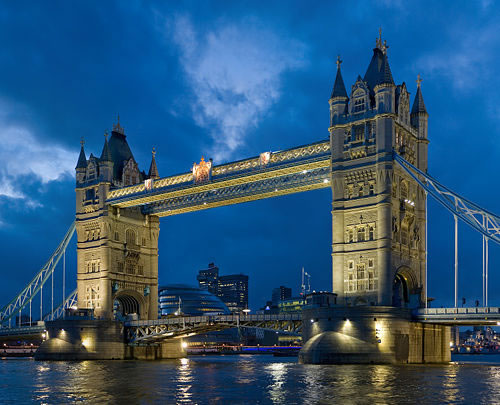
Tower Bridge at twilight. Photo: Diliff
It’s funny to think about ancient traffic jams, but that was why the Tower Bridge in London, England was built. By the end of the 19th century, the development of the eastern part of London caused such a load on the London Bridge that the city decided to build a new bridge.
Construction of the Tower Bridge started in 1886, led by architect Sir Horace Jones and engineer Sir John Wolfe Barry. The design was a bascule (draw) bridge with two towers built on piers, so the bridge wouldn’t interefere with the port facilities nearby.
A year after construction was started, Jones died and his replacement, George D. Stevenson along with Barry decided to modify the design a little bit. Instead of the original brick facade design, the Tower Bridge had a more ornate Victorian Gothic style meant to harmonize it with the nearby Tower of London.
When the bridge opened in 1894, the public was aghast. H. Heathcote Statham, Fellow of the Royal Insitute of British Architect, wrote the familiar sentiment as thus: "The Tower Bridge … represents the vice of tawdriness and pretentiousness, and of falsification of the actual facts of the structure." (Source: Waddell, J., Bridge Engineering, Google Books)
But over time, people warmed up to the bridge. Indeed, the Tower Bridge grew to be one of London’s most recognizable landmarks. Even one of its loudest critics, architectural critic Eric de Maré conceded: the British people "have grown fond of the old fraud … and we must admit that it has carried on its task with admirable regularity and efficiency." (Source: Dupré, J., Bridges; 1997 Black Dog & Leventhal Publishers)
1. Golden Gate Bridge
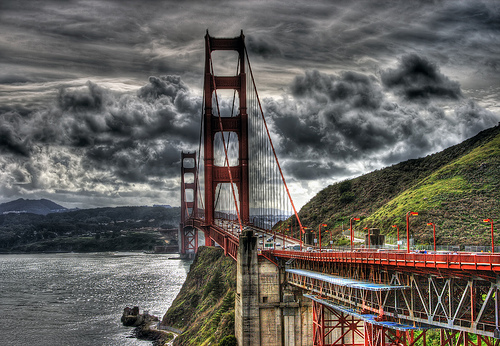
Golden Gate Bridge in HDR as the first big storm of the season hits San Francisco.
Photo: vgm8383
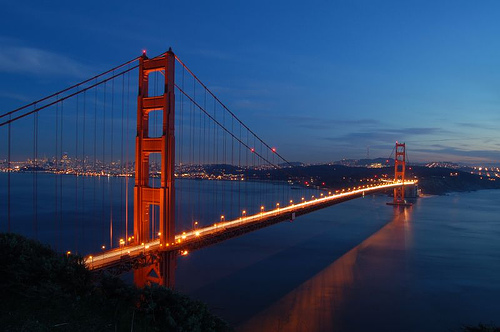
Golden Gate Bridge at sunset. Photo: mischiru
The Golden Gate Bridge is such an iconic symbol of San Francisco (and of suspension bridge in general) that it’s hard to imagine a time when it didn’t exist. But before it was built, most people thought it was an impossible task.
In 1916, the idea of a bridge to cross the Golden Gate, a narrow strait that separated San Francisco Peninsula and the Marin Headlands, was conceived. Though it was almost immediately dismissed as the cost was estimated to be $100 million (astronomical for the time), a veteran bridge builder named Joseph Strauss lobbied for more than two decades to have it built.
The Golden Gate Bridge faced tough opposition: the Department of War thought it would interfere with ship traffic and the Southern Pacific Railroad opposed it as competition to its ferry service. At first, even the public didn’t like the bridge … because Strauss’ original design was deemed too ugly! But Strauss finally won, and after 22-years of drumming up support, the bridge was built. (Photo: SF Museum)
Strauss insisted that the project take worker’s safety seriously. It was the first major bridge project that used hard hats and a safety net. During the course of construction, 19 people were saved by the net to become members of the Halfway to Hell Club. (Source)
The color of the Golden Gate Bridge is actually not red – it’s an orange vermillion called International Orange. The color was chosen specifically because it complements the bridge’s natural surrounding yet enhances its visibility in the fog.
Construction took more than four years, at a cost of $27 million. The Golden Gate Bridge actually came in $1.3 million under budget (though 5 months late). For his work, Strauss got $1 million … and a lifetime bridge pass!
10. Khaju Bridge

Photo: twocentsworth

Khaju Bridge at night. Photo: Jovika
The Khaju Bridge (Pol-e-Khajoo) in Isfahan, Iran, was built in the 17th century by Shah Abbas II. The bridge also serves as a dam, with sluice gates under the archways. When the gates are closed, the water level behind the bridge is raised to irrigate gardens alongside the Zayandeh River.
The Khoju Bridge has two stories of arcades, marked by the distinctive intersecting arches decorated with richly colored tiles. At the center of the bridge, there are two large pavilions, called the Prince Parlors, that were originally reserved for the Shah.
9. Pont du Gard

Pont du Gard. Photo: zak mc
Pont du Gard, an aqueduct spanning the Gard River in southern France, is a masterpiece of Roman engineering. It wasn’t built to transport people (though there is a pedestrian footbridge on it) – instead, it was part of a complex aqueduct system that carried water over 30 miles (about 50 km) to the ancient Roman city of Nemausus (now Nîmes).
The Pont du Gard was built by Marcus Vipsanius Agrippa (63 – 12 BC), the son-in-law of Caesar Augustus. The bridge’s stones, some of which weigh up to 6 tons, were cut perfectly to fit together without any mortar.
The wedge-shaped stones, known as voussoirs, were arranged in three levels, the top-most being the water conduit. So precise was the engineering that the entire system descends only 56 ft. (17 m) vertically – over 30 miles! – to deliver 5 million gallons (20,00 m3) of water to the city.
8. Bridge of Sighs

In the 19th century, Lord Byron named a Venetian limestone bridge across the Rio di Palazzo connecting the Doge’s prison to the interrogation room in the main palace, the Bridge of Sighs (Ponte dei Sospiri). Supposedly, the prisoners would sigh when they look out the window – with stone bars no less – to see their last view of beautiful Venice before their imprisonment, torture or execution.
In reality, Doge’s prison held mostly small-time criminals. Also, the bridge was built in 1600 by Antonio Contino, after the days of the inquisitions and summary executions. Legend has it that if lovers kissed on a gondola underneath the Bridge of Sighs at sunset, their love would last for eternity.
7. Iron Bridge

Iron Bridge. Photo: johnmuk

Iron bridge at night. Notice how the bridge and its reflection make a perfect circle.
Photo: Mark Haythorne
The Iron Bridge, spanning the Severn river in Shropshire, England, isn’t a particularly large or ornate bridge, but it does have something that made it unique: it’s the first bridge made completely out of cast iron. In the 18th century, Shropshire was rich in iron and coal – indeed, there were more iron factories within two-mile radius of the town than any other city in the world. It was also there that iron was first smelt with coke. So it was only natural that the bridge would be made out of iron, a stronger alternative to wood. (Photo of the railing: [ame="http://www.flickr.com/photos/cactus23/2252863037/"]ironbridge_03a on Flickr - Photo Sharing!@@AMEPARAM@@http://farm3.static.flickr.com/2018/2252863037_7a85d9e9a1_m.jpg@@AMEPARAM@@2252863037@@AMEPARAM@@7a85d9e9a1[/ame] [Flickr])
Architect Thomas Farnolls Pritchard proposed a single arch bridge that would let boats pass underneath, but he died before the bridge was built. The construction of the Iron Bridge was carried out by a local master ironworker named Abraham Darby III. About 400 tons (363 tonnes) of cast iron was used, with about 800 separate castings. The Iron Bridge has 5 arch ribs, each cast in two halves. It only took three months to put the parts together (which they did using screws instead of bolts!).
The ease and speed of the Iron Bridge’s construction helped convince engineers of the versatility and strength of iron, and helped usher in the Industrial Revolution era. Darby, however, didn’t fare so well: he severely underestimated the cost to build the bridge, and remained in debt for the rest of his life.
6. Covered Bridges

The West Montrose Covered Bridge on the Grand River, Ontario, Canada. It’s known locally as the Kissing Bridge. Photo: gojumeister
Covered bridges are simply that: bridges that have enclosed sides and roof. Though technically the Bridge of Sigh, Ponte Vecchio, and the Wind and Rain Bridges in this list are covered bridges, this term usually means simple, single-lane bridges in rural settings.
Before they are made famous by the 1995 Clint Eastwood film The Bridges of Madison County, "kissing bridges" or "tunnels of love" have been the pride and joy of many small towns across Europe and especially Northern America where more than ten thousands of such bridges were built.
In the 19th century, timber was plentiful and cheap (or, in many cases, free). So it’s natural that these bridges were made of wood. But why were they covered? Well, lovers aside, the real reason was much more practical: the wooden beams of the bridge lasted longer when protected from the elements.
Unfortunately, due to neglect, theft of lumber, vandalism, and fire, most covered bridges in the United States and Canada have disappeared.
5. Ponte Vecchio

Ponte Vecchio. Photo: G|o®g|O

Ponte Vecchio at night. Photo: MrUllmi
The Ponte Vecchio is a medieval bridge over the Arno River. Actually, it’s much more than a bridge – it’s a street, a marketplace, and a landmark of Florence, Italy.
The Ponte Vecchio that we know today was built in 1345 by Taddeo Gaddi after an older span was destroyed in a flood. To finance the bridge, lots along the roadway were rented out to merchants, especially butchers and tanners, to hawk their wares.
In 1565, Duke Cosimo I de Medici ordered an architect named Giorgio Vasari to construct a roofed passageway. Soon after, jewelers, goldsmiths, and merchants of luxury goods pushed out the butchers out of Ponte Vecchio. Centuries of haphazard additions gave the bridge’s distinctive, irregular appearance today.
During World War II, after having survived many floods, the bridge faced its gravest threat: German bombers were blowing up bridges in Florence. It was a direct order from Hitler that spared Ponte Vecchio from certain destruction.
It is said that the word "bankruptcy" came from Ponte Vecchio. When a merchant failed to pay his debt, the table ("banco") he used to sell his wares was broken ("rotto") by soldiers. Not having a table anymore ("bancorotto"), meant the seller was bankrupt.
4. The Wind and Rain Bridge

Chengyang Bridge. Photo: mazakii that genius
The wind and rain bridges were a type of bridge built by the Dong people (a minority ethnic group) in China. Because they live in the lowlands and the valleys with many rivers, the Dong people are excellent bridge builders. They are called "wind and rain" bridges because the covered bridges not only let people cross the river, but also protect them from the elements.
The Dong people don’t use nails or rivets to build these bridges – instead, they dovetail all of the wood. The largest and most magnificent is the Chenyang Bridge, spanning the Linxi River near the Dong village of Maan. The bridge is about 100 years old, and like all wind and rain bridges, it was built without a single nail.
3. Brooklyn Bridge

Brooklyn Bridge. Photo: Dennis Gerbeckx

Brooklyn Bridge at sunrise. Photo: LemonSunrise
In 1855, engineer John Roebling started to design a bridge that at the time would be the longest suspension bridge in the world, with towers being the tallest structures in the Western Hemisphere: the Brooklyn Bridge in New York.
Today, the Brooklyn Bridge is one of the main crossings of the East River and one of the most heavily trafficked bridges in the world. But in the late 19th century, it took Roebling more than 14 years to convince the city to build the bridge.
After he got approval, Roebling was surveying a site when his foot was crushed by a ferry. Three weeks before the scheduled groundbreaking, he died of tetanus. His son, an engineer named Washington Roebling took over the project.
When the Brooklyn Bridge was opened, Emily was honored with the first ride over the bridge. She held a rooster, a symbol of victory, in her lap. Washington himself rarely visited the bridge till his death in 1926.
One interesting note about the Brooklyn Bridge: it stood fast while other bridges built around the same time had crumbled. Engineers credit Roebling for designing a bridge and truss system six times as strong as he thought it needed to be!
2. Tower Bridge

Tower Bridge at twilight. Photo: Diliff
It’s funny to think about ancient traffic jams, but that was why the Tower Bridge in London, England was built. By the end of the 19th century, the development of the eastern part of London caused such a load on the London Bridge that the city decided to build a new bridge.
Construction of the Tower Bridge started in 1886, led by architect Sir Horace Jones and engineer Sir John Wolfe Barry. The design was a bascule (draw) bridge with two towers built on piers, so the bridge wouldn’t interefere with the port facilities nearby.
A year after construction was started, Jones died and his replacement, George D. Stevenson along with Barry decided to modify the design a little bit. Instead of the original brick facade design, the Tower Bridge had a more ornate Victorian Gothic style meant to harmonize it with the nearby Tower of London.
When the bridge opened in 1894, the public was aghast. H. Heathcote Statham, Fellow of the Royal Insitute of British Architect, wrote the familiar sentiment as thus: "The Tower Bridge … represents the vice of tawdriness and pretentiousness, and of falsification of the actual facts of the structure." (Source: Waddell, J., Bridge Engineering, Google Books)
But over time, people warmed up to the bridge. Indeed, the Tower Bridge grew to be one of London’s most recognizable landmarks. Even one of its loudest critics, architectural critic Eric de Maré conceded: the British people "have grown fond of the old fraud … and we must admit that it has carried on its task with admirable regularity and efficiency." (Source: Dupré, J., Bridges; 1997 Black Dog & Leventhal Publishers)
1. Golden Gate Bridge

Golden Gate Bridge in HDR as the first big storm of the season hits San Francisco.
Photo: vgm8383

Golden Gate Bridge at sunset. Photo: mischiru
The Golden Gate Bridge is such an iconic symbol of San Francisco (and of suspension bridge in general) that it’s hard to imagine a time when it didn’t exist. But before it was built, most people thought it was an impossible task.
In 1916, the idea of a bridge to cross the Golden Gate, a narrow strait that separated San Francisco Peninsula and the Marin Headlands, was conceived. Though it was almost immediately dismissed as the cost was estimated to be $100 million (astronomical for the time), a veteran bridge builder named Joseph Strauss lobbied for more than two decades to have it built.
The Golden Gate Bridge faced tough opposition: the Department of War thought it would interfere with ship traffic and the Southern Pacific Railroad opposed it as competition to its ferry service. At first, even the public didn’t like the bridge … because Strauss’ original design was deemed too ugly! But Strauss finally won, and after 22-years of drumming up support, the bridge was built. (Photo: SF Museum)
Strauss insisted that the project take worker’s safety seriously. It was the first major bridge project that used hard hats and a safety net. During the course of construction, 19 people were saved by the net to become members of the Halfway to Hell Club. (Source)
The color of the Golden Gate Bridge is actually not red – it’s an orange vermillion called International Orange. The color was chosen specifically because it complements the bridge’s natural surrounding yet enhances its visibility in the fog.
Construction took more than four years, at a cost of $27 million. The Golden Gate Bridge actually came in $1.3 million under budget (though 5 months late). For his work, Strauss got $1 million … and a lifetime bridge pass!
Član
- Učlanjen(a)
- 30.06.2010
- Poruka
- 248
...prva slika most Slobode,u Budimpestu,a druga u Dubai most Ka hotelu sa 7 zvezdica
--------------------------------------------------------------------------
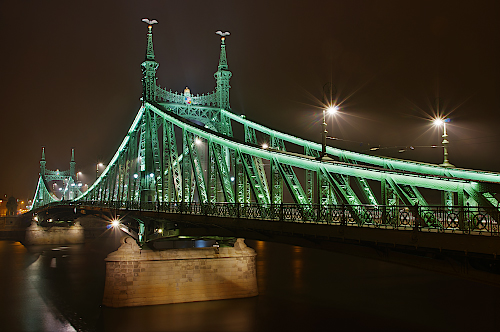
Dodato posle 5 minuta:
--------------------------------------------------------------------------

--------------------------------------------------------------------------

Dodato posle 5 minuta:
--------------------------------------------------------------------------

Poslednja izmena:
Član
- Učlanjen(a)
- 29.10.2009
- Poruka
- 1.416
moctovi....


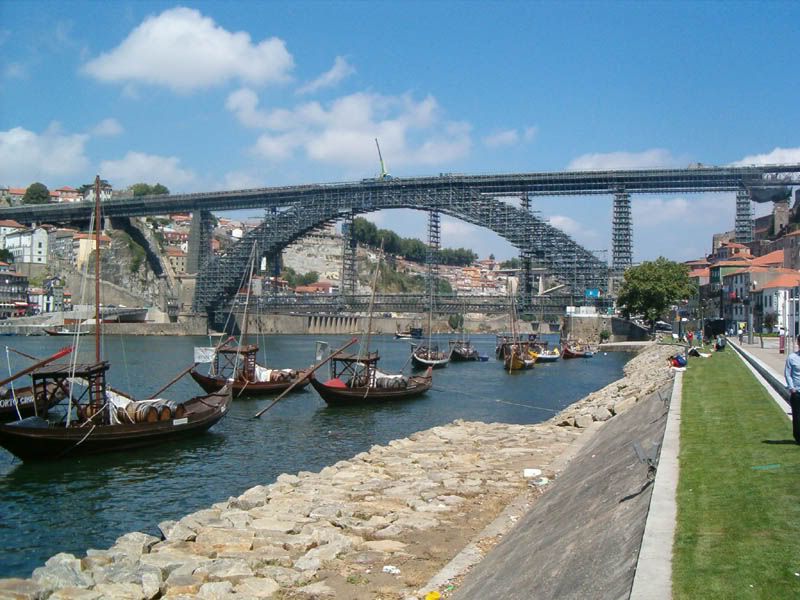




Tower Bridge, pokretni most preko reke Temze, sagrađen u periodu od 1886.-1894. godine prema nacrtima Sir Horacea Jonesa i inžinjera Sir Johna Wolfea Barrya

novi most u veneciji
Most "Dom Luis I", Porto

Most "Octávio Frias de Oliveira", Sao Paulo

najlepsi most, brasilia



LEGEND
- Učlanjen(a)
- 14.12.2009
- Poruka
- 29.042
Arslanagića most
Arslanagića most na rijeci Trebisnjici je podigao Mehmed Paša Sokolović, a otvoren je 1574.godine. Bio je to most koji je povezivao centralnu Bosnu i Novi (današnji Herceg Novi, tada u sastavu Bosne u okviru Osmanskog carstva), preko njega je išla skoro sva trgovina, najviše so. 1687. Mlečani su zauzeli Novi što je izazvalo povlačenje bogatog muslimanskog stanovništva prema Trebinju, i most je izgubio na značaju. Na to je također utjecala izgradnja puteva prema Dubrovniku. Jedan od muslimana iz Novog je bio i Arslan-aga koji je dobio zadatak da naplaćuje mostarinu, napravio je kuću odmah pored mosta. Vremenom je tu niklo cijelo selo, koje se zvalo Arslanagići, pa se i most počeo nazivati Arslanagića most, po njenom mostaru.
Krajem 2.svjetskog rata most su minirali četnici u očajničkom pokušaju da zaustave partizane. Srećom, mine nisu u potpunosti eksplodirale pa je oštećeno samo lijevo krilo mosta. Drugo oštećenje mosta se desilo 1965. kad su vlasti odlučile na tom mjestu praviti hidrocentralu. Most je rastavljen, kamen po kamen, i stajao je na obližnjem polju više godina. Legenda kaže da je tada bilo ponuda iz inostranstva za kupovinu mosta, od kojih je najkonkretnija došla iz Kanade. Ipak, godine 1970. je počelo premještanje i nakon dvije godine slaganja (kameni blokovi su bili obilježeni brojevima i transportovani čamcima) most je ponovo otvoren, ovaj put nekoliko kilometara niže, u trebinjskom naselju Gradina. Selo Arslanagića most je svojim većim dijelom potopljeno i ostalo je samo nekoliko kuća koje iznad nivoa jezera.
Novi epilog oko Arslanagića mosta nastao je 1993. godine, rasplamsavanjem rata u Bosni i Hercegovini. Naime, odlukom tadašnjeg gradonačelnika Trebinja, Božidara Vučurevića, naziv mosta je promijenjen u Perovića most, navodno, tvrdeći da su Arslanagići postali od porodice Perovića. Također je promijenjeno i ime sela u Perovića most. Danas, cijelih jedanaest godina od završetka rata u Bosni i Hercegovini, koja je uređena Daytonskim sporazumom, naziv mosta i sela nije promijenjen, ali ga narod i dalje zove njegovim originalnim imenom: Arslanagića most.
Wikipedia





Arslanagića most na rijeci Trebisnjici je podigao Mehmed Paša Sokolović, a otvoren je 1574.godine. Bio je to most koji je povezivao centralnu Bosnu i Novi (današnji Herceg Novi, tada u sastavu Bosne u okviru Osmanskog carstva), preko njega je išla skoro sva trgovina, najviše so. 1687. Mlečani su zauzeli Novi što je izazvalo povlačenje bogatog muslimanskog stanovništva prema Trebinju, i most je izgubio na značaju. Na to je također utjecala izgradnja puteva prema Dubrovniku. Jedan od muslimana iz Novog je bio i Arslan-aga koji je dobio zadatak da naplaćuje mostarinu, napravio je kuću odmah pored mosta. Vremenom je tu niklo cijelo selo, koje se zvalo Arslanagići, pa se i most počeo nazivati Arslanagića most, po njenom mostaru.
Krajem 2.svjetskog rata most su minirali četnici u očajničkom pokušaju da zaustave partizane. Srećom, mine nisu u potpunosti eksplodirale pa je oštećeno samo lijevo krilo mosta. Drugo oštećenje mosta se desilo 1965. kad su vlasti odlučile na tom mjestu praviti hidrocentralu. Most je rastavljen, kamen po kamen, i stajao je na obližnjem polju više godina. Legenda kaže da je tada bilo ponuda iz inostranstva za kupovinu mosta, od kojih je najkonkretnija došla iz Kanade. Ipak, godine 1970. je počelo premještanje i nakon dvije godine slaganja (kameni blokovi su bili obilježeni brojevima i transportovani čamcima) most je ponovo otvoren, ovaj put nekoliko kilometara niže, u trebinjskom naselju Gradina. Selo Arslanagića most je svojim većim dijelom potopljeno i ostalo je samo nekoliko kuća koje iznad nivoa jezera.
Novi epilog oko Arslanagića mosta nastao je 1993. godine, rasplamsavanjem rata u Bosni i Hercegovini. Naime, odlukom tadašnjeg gradonačelnika Trebinja, Božidara Vučurevića, naziv mosta je promijenjen u Perovića most, navodno, tvrdeći da su Arslanagići postali od porodice Perovića. Također je promijenjeno i ime sela u Perovića most. Danas, cijelih jedanaest godina od završetka rata u Bosni i Hercegovini, koja je uređena Daytonskim sporazumom, naziv mosta i sela nije promijenjen, ali ga narod i dalje zove njegovim originalnim imenom: Arslanagića most.
Wikipedia





LEGEND
- Učlanjen(a)
- 14.12.2009
- Poruka
- 29.042
Najopasniji viseci most
Viseći most “Huseini” nalazi se u Pakistanu iznad jezera Borit. Širom sveta je poznat kao najopasniji viseći most na svetu – jako je star i uzak, a da ne govorimo o daskama koje fale. Sada znate pravi smisao fraze “daske koje život znače”






Viseći most “Huseini” nalazi se u Pakistanu iznad jezera Borit. Širom sveta je poznat kao najopasniji viseći most na svetu – jako je star i uzak, a da ne govorimo o daskama koje fale. Sada znate pravi smisao fraze “daske koje život znače”






